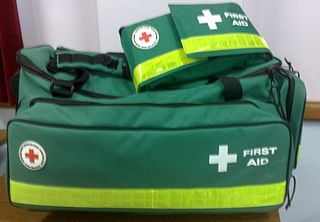
A first aid kit or medical kit is a collection of supplies and equipment used to give immediate medical treatment, primarily to treat injuries and other mild or moderate medical conditions. There is a wide variation in the contents of first aid kits based on the knowledge and experience of those putting it together, the differing first aid requirements of the area where it may be used, and variations in legislation or regulation in a given area.

A bandage is a piece of material used either to support a medical device such as a dressing or splint, or on its own to provide support for the movement of a part of the body. When used with a dressing, the dressing is applied directly on a wound, and a bandage used to hold the dressing in place. Other bandages are used without dressings, such as elastic bandages that are used to reduce swelling or provide support to a sprained ankle. Tight bandages can be used to slow blood flow to an extremity, such as when a leg or arm is bleeding heavily.

Elastoplast is a brand of adhesive bandages and medical dressing made by Beiersdorf.

A menstrual pad, or simply a pad, is an absorbent item worn by women in their underwear when menstruating, bleeding after giving birth, recovering from gynecologic surgery, experiencing a miscarriage or abortion, or in any other situation where it is necessary to absorb a flow of blood from the vagina. A menstrual pad is a type of menstrual hygiene product that is worn externally, unlike tampons and menstrual cups, which are worn inside the vagina. Pads are generally changed by being stripped off the pants and panties, taking out the old pad, sticking the new one on the inside of the panties and pulling them back on. Pads are recommended to be changed every 3–4 hours to avoid certain bacteria that can fester in blood; this time also may differ depending on the kind worn, flow, and the time it is worn.

An orthopedic cast, or simply cast, is a shell, frequently made from plaster or fiberglass, that encases a limb to stabilize and hold anatomical structures—most often a broken bone, in place until healing is confirmed. It is similar in function to a splint.

A field dressing or battle dressing is a kind of bandage intended to be carried by soldiers for immediate use in case of wounds. It consists of a large pad of absorbent cloth, attached to the middle of a strip of thin fabric used to bind the pad in place. Field dressings are issued in sealed waterproof pouches to keep them clean and dry; the pouch can be torn open when required.
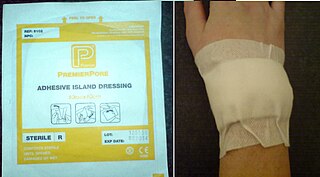
A dressing or compress is a sterile pad applied to a wound to promote healing and protect the wound from further harm. A dressing is designed to be in direct contact with the wound, as distinguished from a bandage, which is most often used to hold a dressing in place. Many modern dressings are self-adhesive.
An occlusive dressing is an air- and water-tight trauma medical dressing used in first aid. These dressings are generally made with a waxy coating so as to provide a total seal, and as a result do not have the absorbent properties of gauze pads. They are typically used to treat open, or "sucking," chest wounds to prevent a tension pneumothorax. They are also used in conjunction with a moist sterile dressing for intestinal evisceration.
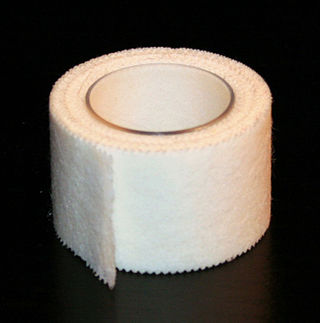
Surgical tape or medical tape is a type of pressure-sensitive adhesive tape used in medicine and first aid to hold a bandage or other dressing onto a wound. These tapes usually have a hypoallergenic adhesive which is designed to hold firmly onto skin, dressing materials, and underlying layers of tape, but to remove easily without damaging the skin. They allow air to reach the skin ("breathable"). Some breathable tapes such as kinesiology tape, and other elastic bandages with adhesive are made of cotton. Surgical tape is often white because it contains zinc oxide, which is added to help prevent infections. Tapes made of porous material, such as 3M Micropore, are widely used.

Gauze is a thin, translucent fabric with a loose open weave. In technical terms, "gauze" is a weave structure in which the weft yarns are arranged in pairs and are crossed before and after each warp yarn, keeping the weft firmly in place. This weave structure is used to add stability to the fabric, which is important when using fine yarns loosely spaced. However, this weave structure can be used with any weight of yarn, and can be seen in some rustic textiles made from coarse hand-spun plant fiber yarns. Gauze is widely used for medical dressings.
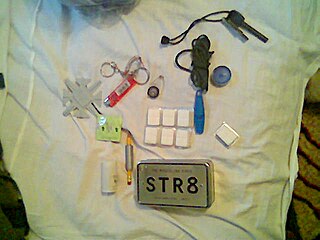
A mini survival kit contains essential outdoor survival tools and supplies. It is intended to be carried on one's person at all times, be appropriate to all environments, and be a comprehensive kit without being too large. Mini survival kits are intended to provide the basic needs of a survival situation, self-rescue, assistance or a return to normalcy in optimum situations.
Liquid bandage is a topical skin treatment for minor wounds which binds to the skin to form a protective polymeric layer that keeps dirt and germs out and moisture in.
Tape or Tapes may refer to:

Wound closure strips are porous surgical tape strips which can be used to close small wounds. They are applied across the laceration in a manner which pulls the skin on either side of the wound together. Wound closure strips may be used instead of sutures (stitches) in some injuries, because they lessen scarring and are easier to care for.

Inadine is an iodine-containing non-sticky surgical dressing consisting of a knitted viscose fabric with a polyethylene glycol base that contains and slowly releases the antiseptic povidone-iodine (PVP-1). It is applied to superficial wounds.

The Emergency Bandage or Israeli bandage is a specially designed, first-aid device that is used to stop bleeding from hemorrhagic wounds caused by traumatic injuries in pre-hospital emergency situations. First used for saving lives during a NATO peacekeeping operation in Bosnia and Herzegovina, the bandage was successfully used during operations Enduring Freedom and Iraqi Freedom. The bandage was nicknamed "Israeli bandage" by American soldiers and has been "the bandage of choice for the US Army and special forces." The Israeli Bandage was included in the first aid kits of emergency personnel and first responders at the 2011 Tucson shooting, and was used to treat some victims of the shooting.

Pressure-sensitive tape or pressure-sensitive adhesive tape is an adhesive tape that will stick with application of pressure, without the need for a solvent or heat for activation. It is known also in various countries as self-stick tape, sticky tape, or just adhesive tape and tape, as well as genericized trademarks, such as Sellotape, Durex (tape), Scotch tape, etc.
Compeed is a brand of hydrocolloid gel plasters for treating blisters, corns, cracked heels and cold sores. It was originally developed by Lars Backsell while working in Denmark for Coloplast A/S. The brand was sold to Johnson & Johnson in May 2002, then acquired by HRA Pharma in 2017. Compeed plasters are still manufactured by Coloplast.
Plaster is a building material used for coating walls and ceilings.
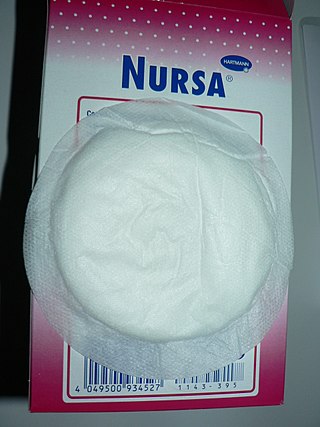
A nursing pad is a cloth or disposable pad worn against the nipple and breast of a nursing mother to absorb any milk that may leak between feedings. It is inserted between the bra and the breast. Disposable pads are common and located easily online or in specialty stores. Reusable cloth pads can be washed and used over. These may be less expensive. Changing the pad when it is wet will keep the nipple clean and dry.



















